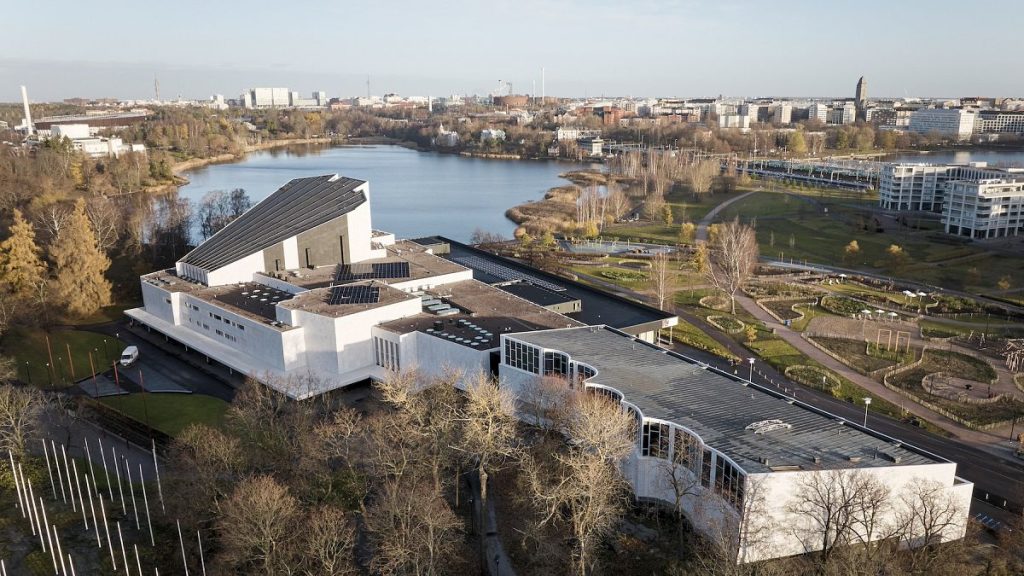Finlandia Hall, the architectural masterpiece by Alvar Aalto in Helsinki, has emerged revitalized after a three-year, €136 million renovation, poised to become a more accessible and engaging public space. This extensive refurbishment addressed long-standing issues, introduced new amenities, and significantly broadened the hall’s role in the city’s cultural landscape. The most noticeable change was the complete replacement of the building’s iconic marble façade, a necessary step to resolve the persistent cracking that had plagued the original Carrara marble since its construction in 1971. The new marble, sourced from Northern Italy after rigorous research and testing, is expected to endure for at least half a century, promising a lasting solution to a previously recurring problem. This careful material selection reflects a commitment to preserving the building’s aesthetic integrity while ensuring its longevity.
Beyond the façade restoration, the renovation encompassed a range of enhancements designed to elevate the visitor experience and expand the hall’s functionality. The addition of a wine café and a bistro, scheduled to open shortly, provides new opportunities for casual enjoyment and social interaction within the iconic space. These additions transform Finlandia Hall from a primarily event-driven venue to a destination where people can relax, socialize, and appreciate the architectural beauty. Further enriching the visitor experience is a curated art exhibition featuring works by prominent Finnish artists, strategically placed throughout the hall. This integration of art within the architectural context creates a dynamic interplay between the two disciplines, offering visitors a multi-layered cultural experience. Moreover, two newly converted guest apartments are now available for overnight stays, inviting a deeper engagement with the building and its surrounding environment.
A significant highlight of the renovation is the creation of a permanent exhibition dedicated to Alvar Aalto and his collaborators, including his wives Aino and Elissa Aalto, set to open in June. This exhibition will finally provide a dedicated space in Helsinki to celebrate the legacy of one of Finland’s most influential design figures, filling a noteworthy gap in the city’s cultural offerings. Aalto’s international renown makes the absence of such a space until now even more striking. The exhibition promises to offer a comprehensive exploration of Aalto’s work and philosophy, allowing visitors to delve into the mind of a master architect and appreciate the breadth and depth of his contributions to design. The positioning of this exhibition within Finlandia Hall, one of Aalto’s most celebrated creations, further enhances its significance, providing a tangible connection between the architect’s vision and its realization.
Complementing the indoor additions, the outdoor café terrace now features a striking sculpture, “Viihdyttäjän vapaapäivä” (Entertainer’s Day Off), by artist Kimmo Schroderus. This imposing five-meter-tall, 500-kilogram artwork adds a contemporary artistic element to the surrounding landscape, creating a dialogue between the existing architecture and new creative expressions. This careful integration of art into the outdoor space further enhances the overall visitor experience, offering points of interest and reflection beyond the confines of the building itself. The sculpture’s presence contributes to the transformation of Finlandia Hall into a dynamic cultural hub, seamlessly blending architectural heritage with contemporary artistic interventions.
The reopening signifies a fundamental shift in Finlandia Hall’s role within the city. While it will continue to host prestigious international events, such as the 50th-anniversary celebration of the OSCE, it will now be far more accessible to the public. Previously primarily a venue for ticketed events and conferences, the renovated hall welcomes locals and visitors daily without restrictions. This change in policy marks a democratization of access to a significant cultural landmark, allowing everyone to appreciate its architectural beauty and engage with its expanded offerings. The transformation effectively positions Finlandia Hall as a vibrant community hub, integrating it more deeply into the fabric of Helsinki’s cultural life.
This shift towards greater public accessibility is a defining aspect of the renovation. It underscores the desire to make Finlandia Hall a shared cultural resource, enjoyed by both residents and tourists alike. The café, bistro, art exhibition, and permanent Aalto exhibition all contribute to creating a welcoming and engaging environment that encourages spontaneous visits and extended exploration. Finlandia Hall’s revitalization represents not just a physical restoration of a landmark building but a conceptual transformation of its purpose and place within the community, emphasizing its role as a vibrant and accessible cultural center that celebrates architectural heritage, artistic expression, and community engagement.














